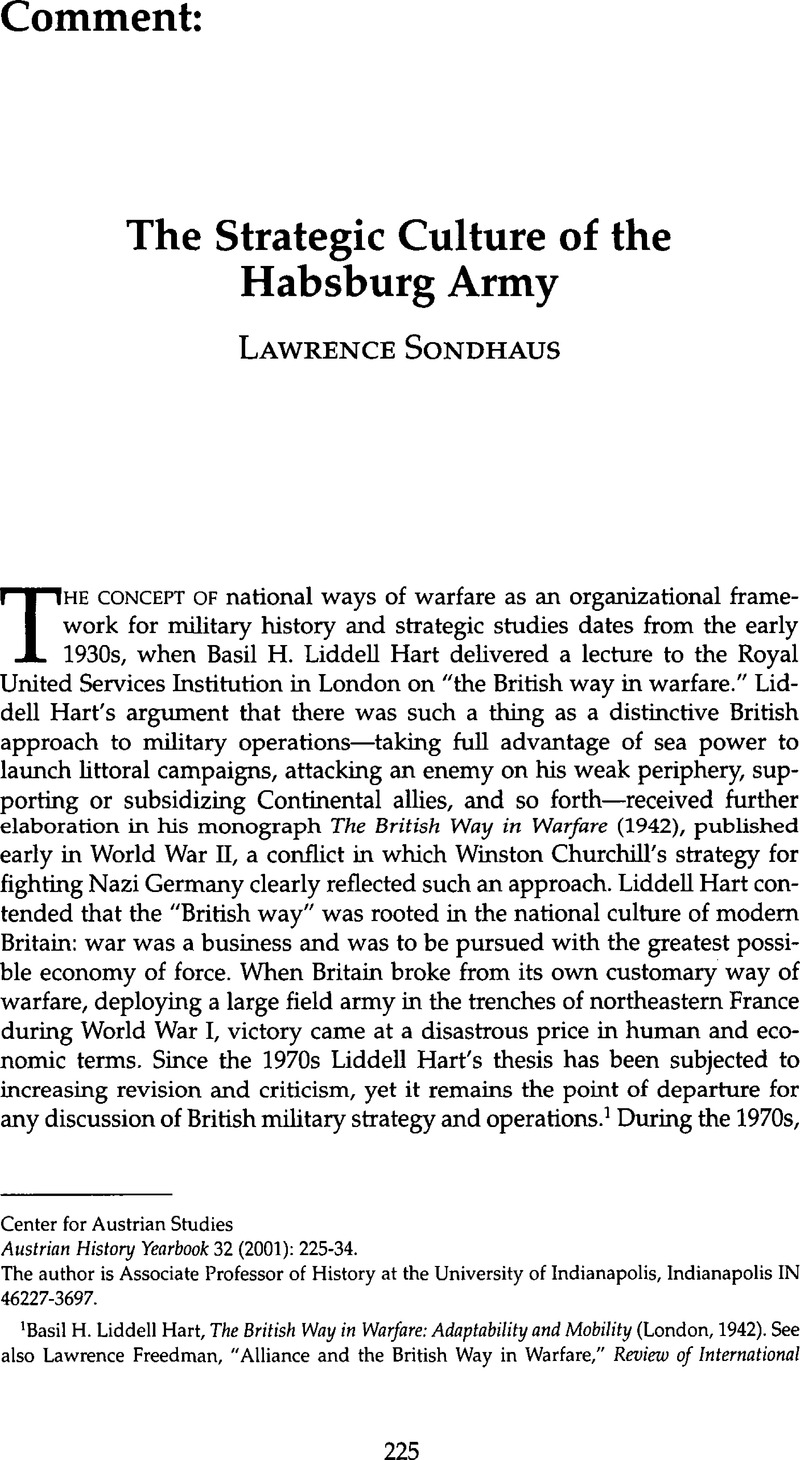Article contents
The Strategic Culture of the Habsburg Army
Published online by Cambridge University Press: 10 February 2009
Abstract

- Type
- Comments
- Information
- Copyright
- Copyright © Center for Austrian Studies, University of Minnesota 2001
References
1 Liddell Hart, Basil H., The British Way in Warfare: Adaptability and Mobility (London, 1942).Google Scholar See also Lawrence, Freedman, “Alliance and the British Way in Warfare,” Review of International Studies 21 (1995): 145–58,Google Scholar and Alex, Danchev, “Liddell Hart and the Indirect Approach,” Journal of Military History 63 (1997): 313–37.Google Scholar
2 For example, Weigley, Russell F., The American Way of War: A History of United States Military Strategy and Policy (New York, 1973);Google ScholarKiernan, Frank A. Jr and Fairbank, John K., eds., Chinese Ways in Warfare (Cambridge, Mass., 1974);CrossRefGoogle ScholarBaxter, William P., The Soviet Way of Warfare (London, 1986).Google Scholar See also Hanson, Victor Davis, The Western Way of War: Infantry Battle in Classical Greece (New York, 1989).Google Scholar
3 Snyder, Jack L., The Soviet Strategic Culture: Implications for Limited Nuclear Operations, RANDR-2154-AF (Santa Monica, Calif., 1977).Google Scholar
4 For example, Alan, Macmillan, “Strategic Culture and National Ways in Warfare: The British Case,” journal of the Royal United Services Institution 140 (1995): 33–38.Google Scholar See also Colin, Mclnnes, Hot War, Cold War: The British Army's Way in Warfare, 1945–95 (London, 1996), especially 1–3,26–31, and Danchev, “Liddell Hart and the Indirect Approach,” 327.Google Scholar
5 McInnes, Hot War, Cold War, 3.
6 Rothenberg, Gunther E., “The Shield of the Dynasty: Reflections on the Habsburg Army, 1649–1918,” in this volume, and in his previous works, including The Army of Francis Joseph (West Lafayette, Ind., 1976; reprint ed., 1998);Google ScholarNapoleon's, Great Adversaries: The Archduke Charles and the Austrian Army, 1792–1814 (Bloomington, Ind., 1982); The Military Border in Croatia, 1740–1881 (Chicago, 1966); and The Austrian Military Border in Croatia, 1522–1747 (Champaign–Urbana, III., 1960).Google Scholar
7 Alphons von, Wrede, Geschichte der k.u.k. Wehrmacht: Die Regimenter, Corps, Branchen und Anstalten von 1618 bis Ende des XIX. Jahrhunderts, 7 vols. (Vienna, 1893–1900), 1: 40, 95–103; supplements 6 and 7. Until the late 1800s, even in official correspondence, regiments more often than not continued to be referred to by the name of their proprietary colonel (Inhaber) rather than their number.Google Scholar
8 Lawrence, Sondhaus, In the Service of the Emperor: Italians in the Austrian Armed Forces, 1814–1918 (Boulder, Colo., 1990), 59–60.Google Scholar
9 Hanson, Victor Davis, “Western Military Dynamism and the Legacy of Hellenism,” paper presented at the annual meeting of the American Historical Association, Chicago, III., January 8, 2000.Google Scholar
10 With its own population booming at a rate higher than that of Austria–Hungary, Germany, in fact, did not maintain such a level of military strength in peacetime. Only on the eve of World War I did the army insist on, and the Reichstag fund, an expansion of the army to a level of strength equal to 1 percent of the population.
11 Owen, Connelly, Blundering to Glory: Napoleon's Military Campaigns (Wilmington, Del., 1987), 1.Google Scholar
12 For more detail on the arguments raised in the following paragraphs, see Lawrence, Sondhaus, Franz Conrad von Hötzendorf: Architect of the Apocalypse (Boston, 2000).Google Scholar
- 1
- Cited by




